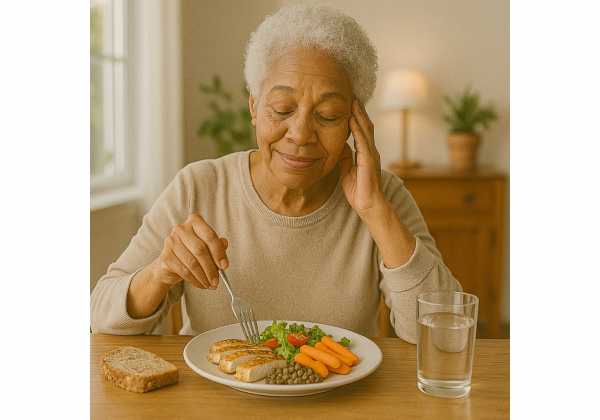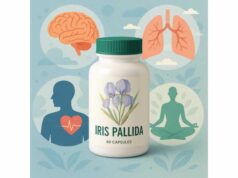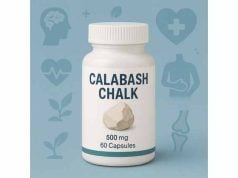
A shifting appetite in midlife and later life is common, but it is not random. Biology, medications, sleep, activity, and daily habits nudge hunger signals up or down. The result can be a quiet drift toward eating too little—risking muscle loss—or toward grazing on calorie-dense, low-protein foods that leave you unsatisfied. This guide translates the science of appetite in aging into practical steps: how to meet protein needs, use flavor to make food appealing, and time meals so energy feels steady. You will learn how to build satisfying snacks and liquid options when chewing is hard, what to watch on the scale and tape measure, and when an appetite change deserves medical attention. For a broader foundation on pattern-based eating that supports longevity—protein distribution, plant variety, and polyphenols—see our overview of longevity-focused nutrition strategies.
Table of Contents
- Drivers of Low or High Appetite in Midlife and Older Adults
- Protein and Energy Density to Meet Daily Needs
- Palatability and Flavor Boosters: Umami, Herbs, and Acids
- Meal Timing and Distribution for Stable Energy
- Snack Ideas and Liquid Nutrition When Chewing Is Hard
- Monitoring Weight, Muscle, and Appetite Signals
- When to Seek Evaluation for Appetite Changes
Drivers of Low or High Appetite in Midlife and Older Adults
Appetite reflects a conversation between your brain, gut, muscles, and environment. With age, several inputs change at once, so hunger and fullness can feel less predictable. Understanding these drivers helps you match strategies to causes instead of forcing one-size-fits-all rules.
Physiology first. The “anorexia of aging” describes a tendency toward lower appetite and earlier fullness. Several mechanisms contribute: higher baseline levels of satiety signals after meals; slower gastric emptying after large or high-fat meals; reduced smell and taste sensitivity that dulls food reward; and a lower resting metabolic rate that modestly reduces energy needs. These shifts are compounded by sarcopenia—gradual loss of muscle—which can reduce spontaneous movement and lower hunger over time, creating a loop of “eat less, move less, lose more muscle.”
Medications matter. Common prescriptions can suppress appetite or change taste: metformin, GLP-1 receptor agonists, SSRIs, SNRIs, opioids, digoxin, and some antibiotics. Others raise reflux or cause nausea, reducing intake. Calcium channel blockers and anticholinergics can slow gut motility, increasing early fullness. Iron and certain osteoporosis drugs can irritate the stomach. Always review new or changed medications when your appetite shifts.
Health conditions influence signals. Untreated hypothyroidism, depression, chronic pain, poor dentition, dry mouth, and anosmia reduce interest in food. Conversely, uncontrolled blood sugar swings, sleep debt, and chronic stress can drive cravings for fast-digesting carbohydrates. Low-grade inflammation from illness can blunt hunger and accelerate muscle breakdown, making adequate protein especially important during recovery.
Lifestyle and social factors play a quieter but persistent role. Irregular schedules, long gaps between meals, solitary eating, and highly processed snack foods nearby can reshape appetite patterns. Dehydration can masquerade as fatigue or low appetite. In hot weather, thirst rises while hunger falls; in colder months, some people experience the opposite.
Red flags versus normal variability. It is normal for appetite to vary with activity, sleep, and stress. It is not normal to have a sustained loss of interest in food, unexplained weight loss, difficulty chewing or swallowing, frequent nausea, or early fullness that limits intake. These deserve evaluation. The strategies in this article aim to nudge appetite in a healthy direction—making meals more appealing, better timed, and nutritionally dense—while you and your clinician investigate underlying causes if symptoms persist.
Protein and Energy Density to Meet Daily Needs
In midlife and older adulthood, you need enough total protein and the right distribution across meals to counter age-related “anabolic resistance”—the higher protein threshold required to trigger muscle building after eating. Practical targets for generally healthy older adults are 1.0–1.2 g protein per kg body weight per day, rising to 1.2–1.5 g/kg/day during illness, rehabilitation, or if you are at risk of malnutrition as advised by your clinician. Equally important: aim for 25–35 g protein at each main meal to reach the per-meal threshold that turns on muscle protein synthesis. Pair these targets with strength or resistance exercise two to three days per week to direct amino acids toward muscle.
Translate the numbers into plates:
- Breakfast: 2 eggs (13 g) plus ¾ cup cottage cheese (20 g) and fruit; or ¾–1 cup Greek yogurt (17–23 g) with 2 Tbsp peanut butter (7 g) and berries.
- Lunch: palm-sized serving of poultry or fish (25–35 g) or 1 cup lentils (18 g) with ½ cup tofu (10 g).
- Dinner: 3–4 oz fish, chicken, or lean meat (22–30 g) or a tofu–edamame stir-fry (30 g).
When appetite is low, raising energy density without increasing volume helps you meet needs:
- Mix olive oil or avocado into salads and grain bowls (1–2 Tbsp adds 120–240 kcal).
- Enrich soups with Greek yogurt, silken tofu, or milk powder to lift protein without heaviness.
- Choose soft, protein-rich foods—eggs, flaky fish, yogurt, skyr, tofu—if chewing is tired.
Protein quality counts, but variety wins. Include dairy or soy (rich in leucine), eggs, fish, poultry, and legumes. If you follow a plant-forward pattern, combine legumes, soy, grains, nuts, and seeds across the day to cover essential amino acids. Most people can meet targets with food; a whey, casein, or soy isolate shake (20–30 g) is useful when appetite or chewing limits intake.
Do not neglect carbohydrates and fats. Older adults often eat too little carbohydrate, which can sap training energy and reduce fiber intake. Pair protein with smart carbs (intact grains, beans, potatoes) and measured fats (olive oil, nuts) to create sustainable meals. If you want deeper guidance on setting daily and per-meal targets, see our breakdown of per-meal protein targets.
Palatability and Flavor Boosters: Umami, Herbs, and Acids
Appetite is not only biology; it is also pleasure. Age-related changes in taste and smell mean you may need more aroma, more temperature contrast, and brighter acidity to make meals satisfying. Palatability strategies let you eat enough without forcing volume.
Build a flavor “toolbox” you can apply to any protein or vegetable:
- Umami amplifiers: tomatoes, mushrooms, parmesan, aged cheese in small amounts, soy sauce/tamari, miso, anchovies, sardines, seaweed, nutritional yeast. A teaspoon of miso whisked into pan sauce or a sprinkle of parmesan on vegetables can transform flavor with minimal effort.
- Acid and brightness: citrus, vinegars (sherry, red wine, apple cider), pickled onions, capers. A splash at the end wakes up a dish—especially useful when smell is muted.
- Fresh herbs: basil, dill, parsley, cilantro, mint. Add a handful off the heat for aroma.
- Aromatics: shallots, scallions, garlic (roasted or sautéed for sweetness), ginger.
- Textural contrast: toasted nuts or seeds for crunch, creamy yogurt or tahini for balance.
Design meals around protein plus produce, then layer flavor:
- Start with a protein base (salmon, tofu, chicken, beans).
- Add a cooking fat that carries flavor (olive oil).
- Build a quick pan sauce (garlic + lemon + parsley; miso + ginger + scallion; tomatoes + capers + olives).
- Finish with acid and herbs.
Temperature matters. Warm soups and stews are soothing in winter and easier to eat when appetite is low; in warmer months, chilled yogurt-based dips and crunchy salads perk up interest. Keep portions manageable and serve seconds rather than overfilling plates.
If cooking regularly feels tiring, lean on high-impact shortcuts: pre-washed greens; frozen vegetables; canned beans; plain rotisserie chicken; pre-cooked lentils; shelf-stable tuna or salmon; microwaveable intact grains. Assemble bowls with a simple formula—grain + protein + two vegetables + sauce.
For more ways to make food flavorful without heaviness or excess charring, see our practical guide to gentler cooking methods that keep meals appealing and easy to digest.
Meal Timing and Distribution for Stable Energy
When you eat is as important as what you eat for appetite, strength, and sleep. A regular meal rhythm stabilizes hunger hormones and makes protein targets easier to hit.
Anchor your day with three protein-forward meals and, if helpful, one snack:
- Morning: A protein-rich breakfast (25–35 g) dampens mid-morning cravings and helps meet daily totals. Examples: eggs with whole-grain toast and tomatoes; skyr with fruit and nuts; tofu scramble with spinach and potatoes.
- Midday: Make lunch your most satisfying meal—protein, vegetables, and an intact grain. This timing aligns with higher daytime insulin sensitivity and gives you energy for activity.
- Evening: Keep dinner earlier and moderate in size. Many people feel best finishing 3–4 hours before bedtime. If hunger returns late, add a small protein-based snack.
Distribute protein evenly rather than loading it at night. Older adults often consume most protein at dinner, leaving breakfast and lunch too light. An even spread (for example, 30 g at each main meal) makes better use of each eating occasion to stimulate muscle building.
Use activity-aligned timing. Plan a protein-containing meal or snack within 2–3 hours of strength or balance training. A short 10–15 minute walk after meals improves blood sugar control and can enhance appetite at the next mealtime.
Travel and irregular days. On days with early appointments or long gaps, pack a simple kit: a shaker with a shelf-stable protein powder, a piece of fruit, a small bag of nuts, and a water bottle. If medications require timing with meals, set reminders so you do not skip protein because of scheduling.
If you want a bigger picture on aligning meals with your body clock and daily movement, explore our guide to meal timing and circadian rhythm.
Snack Ideas and Liquid Nutrition When Chewing Is Hard
When appetite is low, chewing is tiring, or dentures make tough textures unappealing, thoughtful snacks and sips can fill the gap. The goal is high nutrient density in modest portions—protein, fiber, healthy fats, and fluids without excess volume.
Build “two-part” snacks that pair protein with produce or a smart carb:
- Greek yogurt or skyr (¾–1 cup) with berries and 1–2 Tbsp chopped nuts.
- Cottage cheese (¾ cup) with pineapple or tomatoes and pepper.
- Hummus (¼–⅓ cup) with roasted carrots or bell peppers.
- String cheese or mini mozzarella with an apple or grapes.
- Peanut or almond butter (1–2 Tbsp) on whole-grain toast or apple slices.
- Edamame (1 cup) with cherry tomatoes.
- Tuna or salmon pouch on whole-grain crackers.
Create sipping options for days when solids are not appealing:
- Protein smoothie: milk or soy milk (1 cup), Greek yogurt (½ cup), frozen berries (1 cup), ground flax (1 Tbsp), and optional whey/soy isolate (20–25 g) if needed.
- Savory sipper: pureed white-bean and tomato soup blended with olive oil and parmesan; or carrot-ginger soup with yogurt for creaminess.
- High-protein hot chocolate: milk plus 1 scoop casein or whey, whisked and warmed gently; add cinnamon.
Texture modifications make a difference. Choose flaky fish, soft tofu, tender ground meats, mashed beans, stewed or roasted vegetables, and moist grains like oatmeal or polenta. Use broths, olive oil, yogurt, or tahini to add moisture and calories without excess chewing.
If nighttime hunger strikes, choose a small, protein-forward snack to support overnight muscle repair without disturbing sleep: half a cup of cottage cheese, a skyr cup, or a small glass (200–250 mL) of milk. For ideas that also support sleep quality, see our guide to evening nutrition for better sleep.
Hydration supports appetite and comfort. Aim to drink steadily during the day rather than gulping at meals. Include water, milk, kefir, broths, and herbal teas. If plain water is unappealing, add citrus slices or a splash of 100% juice to encourage drinking.
Monitoring Weight, Muscle, and Appetite Signals
A steady appetite is a good sign, but data beats guesswork. Track a few simple measures monthly (or more often during illness) to catch changes early and adjust your plan.
Core metrics
- Body weight: check once weekly under the same conditions. A change of ±2% in a month or ±5% in six months deserves attention, especially if unintentional.
- Waist circumference (at the navel): helps track central fat changes that influence metabolic health and appetite.
- Simple strength measures: time a chair-rise test (stand up from a chair without using hands, five repetitions); measure a 30-second sit-to-stand count; or note how many seconds you can balance on one leg. Strength loss often precedes weight changes.
- Protein check: tally average daily protein over three typical days. If you consistently fall below 1.0 g/kg/day, bump protein at breakfast and lunch first.
- Meal rhythm: note how often you delay breakfast, skip lunch, or eat dinner late. Irregularity often masquerades as “poor appetite.”
Appetite quality audit
- Hunger curve: Do you feel gently hungry before meals and pleasantly full afterward, or do you graze without clear signals?
- Early fullness: Does a small volume stop you? Try smaller, more frequent meals and moister textures; discuss with your clinician if persistent.
- Food interest: If nothing sounds good, use flavor boosters and warm, comforting textures to coax appetite.
- Energy and mood: Low energy and flat mood often track with low protein and irregular meals.
Adjust your plan using a “nudge ladder”:
- Evenly distribute protein (breakfast, lunch, dinner each 25–35 g).
- Add one high-protein snack most days.
- Increase energy density with olive oil, nuts, seeds, or avocado in measured amounts.
- Align meals with activity and finish dinner earlier.
- Use a simple strength routine twice weekly.
If weight tends to drift up when appetite runs high for sweets or snacks, focus on structure, not restriction: plan balanced meals first and use pre-portioned treats. For longer-term strategies that stabilize weight without strict dieting, see our guide to weight maintenance in healthy aging.
When to Seek Evaluation for Appetite Changes
Most appetite fluctuations respond to better protein distribution, more appealing flavors, and improved meal timing. Still, some changes warrant a timely medical evaluation to rule out underlying conditions and to tailor support.
Seek care promptly if you notice:
- Unintentional weight loss of >2–3 kg (5–7 lb) in a month or >5% in six months.
- Persistent early satiety, nausea, vomiting, abdominal pain, or changes in bowel habits lasting more than two weeks.
- Difficulty chewing or swallowing, coughing or choking when eating, or frequent heartburn that limits intake.
- New or worsening fatigue, breathlessness, night sweats, or fevers.
- Depression, anxiety, or social isolation that reduces interest in food.
- Medication changes followed by reduced appetite, taste changes, or gut symptoms.
What evaluation might include
- Medication and supplement review to identify appetite-suppressing or GI-irritating agents.
- Dental and oral health check for denture fit, pain, or dry mouth; targeted fixes can immediately improve intake.
- Screening labs (e.g., thyroid function, iron studies, B-vitamins, markers of inflammation) based on your history.
- Assessment for dysphagia and aspiration risk if coughing or choking is present; referral to speech-language pathology as needed.
- Nutrition plan: individualized protein target, texture modifications, and—when indicated—short-term oral nutrition supplements.
If you are recovering from illness or surgery, your needs temporarily rise. A plan that includes 1.2–1.5 g/kg/day protein, simple resistance exercises (as cleared by your clinician), and higher-energy snacks helps rebuild strength. Coordinate with a registered dietitian for fine-tuning and with physical therapy for a safe, progressive program.
Remember: the aim is not to chase appetite, but to shape your environment and routine so that eating enough good-quality food feels natural. Most people do best with a short list of reliable breakfasts and lunches, flavorful dinners that are easy to repeat, and a few high-protein snacks ready to go.
References
- ESPEN practical guideline: Clinical nutrition and hydration in geriatrics (2022) (Guideline)
- Discussion on protein recommendations for supporting muscle and bone health in older adults: a mini review (2024) (Review)
- Mechanisms of the anorexia of aging—a review (2015) (Review)
- Hydration Status in Older Adults: Current Knowledge and Future Challenges (2023) (Review)
Disclaimer
This article provides general information for educational purposes and is not a substitute for personalized medical advice, diagnosis, or treatment. Always consult your healthcare professional about appetite changes, weight loss, swallowing difficulties, or before making significant changes to your diet, supplements, or medications. If you found this guide useful, please consider sharing it on Facebook, X, or another platform you prefer, and follow us for future updates. Your support helps us continue creating clear, evidence-based resources for healthy aging.




